
Spazi in Frutto
by ERICA BOITO
- View Erica Boita's Biography
Erica Boito is an artist, facilitator and educator. She is a teaching and research assistant at the Faculty of Design and Art, Free University of Bozen / Bolzano, Italy.
Spazi in Frutto: Pre-Text for Action
Erica Boito
This is a story about cultivated biodiversity, about rediscovered emotions and traditions and about the challenge of being public and political in a non-urban space.
In 2011 a group of young women from different educational backgrounds (arts, agronomics, ecology, forestry, architecture) joined together and founded Spazi in Frutto - association for cultivated diversity. The main aim of the project was to foster a caring attitude to landscape through a series of interventions for a specific Alpine context. The association worked in the Alpine province of Belluno, Italy, from 2011 to 2016.
The starting point of Spazi in Frutto's project was the impressive ethnobotanic study on traditional agricultural biodiversity, promoted by the Dolomiti Bellunesi National Park and the Ethnographic Museum of the Province of Belluno. The outcomes of this research were a database of ancient varieties cultivated specifically in the province and a publication1 especially relevant for its anthropological approach.
The study continued with a census of ancient fruit trees present in the territory (lead by the Comunità Montana di Belluno - Ponte nelle Alpi) which resulted in a collection of 49 varieties, among them, apples, pears, grapefruits and plums.
The archive of 49 traditional cultivars became the core of the Spazi in Frutto project. The collection constituted the pre-text for action in a particular Alpine landscape.
Starting from the study of the past and its traditions, recognising the needs and what was lacking in the current situation, and counting on the local resources, Spazi in Frutto added a design perspective for possible action.
The main intervention of Spazi in Frutto consists in the creation of a network of Open Orchards. An Open Orchard is an accessible, free, public and shared orchard. It is a cultural place for leisure time, inspiration, diversity and socialization. In an Open Orchard, fruits, land, resources, labour and cultivars form a commons.
From a political and social point of view, an Open Orchard is an experimental field where communities inhabit a common ground.
Spazi in Frutto set up a nursery of forty ancient tree varieties. Ten Open Orchards were created on public or common land. Each orchard was adopted by a local community, such as a school, an association of citizens or an informal group neighbours.
Throughout the years, Spazi in Frutto accompanied the project with workshops and participatory activities for adults and children on biodiversity, ecology and fruit-growing. Great energy was spent in activating the communities and finding adequate locations for the orchards. At the conclusion of the project, another one-hundred plants were given to private citizens, with the idea of spreading the values of (bio)-diversity and land caring from the public to private sphere.
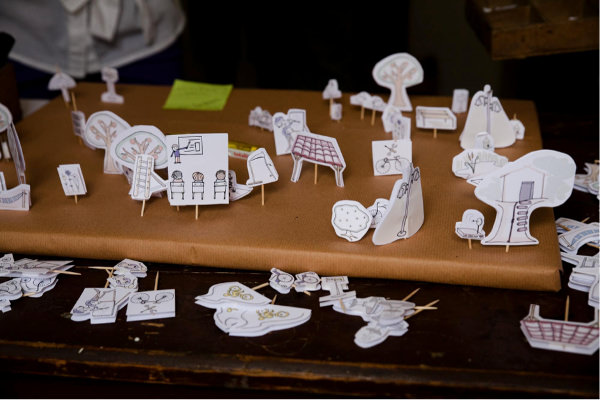
Game designed for participatory activities.
Notes on text and author
I am the artist of Spazi in Frutto's team. While the other members enjoy spending a long time in the nursery, I like to water soft and intangible "things". Thus I was given the task of telling the story of Spazi in Frutto's five years of activity.
Our interventions were based on the concept of diversity. Despite having a leader, they were always characterized by interdisciplinary and collective dynamics. Therefore, I wanted the writing to be a polyphonic composition, inspired by different participants' voices, in dialogue among each other.
Participants who accepted to collaborate on this report were asked to describe Spazi in Frutto and to indicate the crucial themes and questions around it. The italics mark excerpts from these participants' conversations.
Individuals involved for this report are: a young agronomist member of the team since the beginning; people who got to know the project and helped in designing and carrying out different activities (gardening, workshops, events,...); a representative of a group of citizens that adopted an Open Orchard.
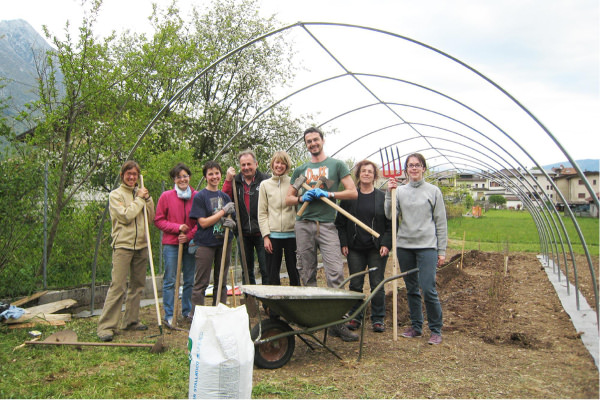
Starting the nursery. The first Spazi in Frutto team, in 2011.
Archive of Emotions
Spazi in Frutto it is an expression of the global movement of community gardening. However, its own specificity is given by the ancient varieties and vigorous rootstocks employed in the project.
Cultivating long-living trees demands a long-term perspective and a permanent use of the space for gardening purposes. Nevertheless, the reintroduction of ancient cultivars generates a strong sense of belongingness to the land where the varieties were selected and grown in the past.
The collection of fruit varieties cultivated by our forebears is a pre-text of action, it operates as a pre-weaving of the social (and scientific) fabric, as a prior texture, necessary to engage semi-rural citizens, raise environmental awareness, encourage openness to diversity and activate spaces for debates and collective practices.
The essence of the project is to bring the archive to life and make it accessible to citizens as a lively space.
The scientific studies in the fields of environmental science, botany, history and anthropology play a fundamental part in the interventions. Thanks to these studies, the project can connect with the local history and act in the present with consistency. If commercial varieties were used instead of ancient ones, probably the same results would not have been achieved, in terms of community engagement. Playing with ancient cultivars, such as Pom de la Roseta (Little Rose Apple), made the elderly remember the flavours of their childhood. At the same time, it gave younger members the possibility to interpret and question their origins through agricultural practices.
In addition, the database of tree varieties strengthens the identity and concreteness of the project. It makes the interventions more understandable by the majority of the local population. Spazi in frutto was often identified as a tree nursery, despite the fact that the nursery in itself was just one element- albeit very tangible and visible- of a more complex action.
The archive is a pretext for inviting people to take care of the land(scape) collectively and to question their agricultural practices, for introducing bio-diversity values and for making experiments in semi-rural terrains.
A general feeling of attachment and caring for specific plants or practices became evident in discourses on the streets and in newspapers, at public level.
Today, when I was cycling on the street, a car passed by me, slowed down and stopped.The driver rolled down the window and greeted me. It was a young neighbour I had never known the name of.
He asked how our young trees were doing in the nursery. Enthusiastically, he told me he had managed to get an ancient variety of peach tree, resistant to our alpine weather: "You don't need to do anything to it, just plant it and let it grow!".
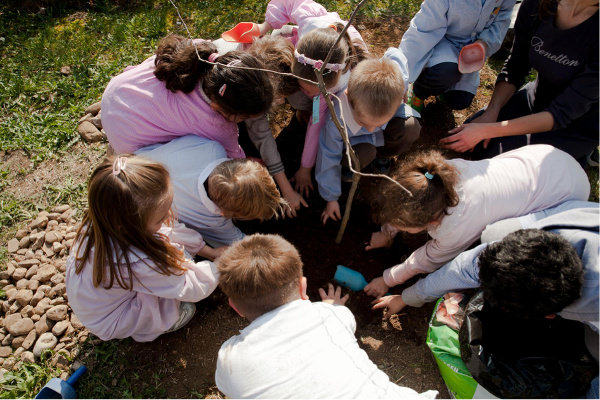
Planting an Open Orchard at a kindergarten.
How to Be Public
I am an architect and when I was a child I wanted to be an inventor. Spazi in Frutto was a good opportunity to meet new people in a place where I had just moved to.
I believe the project fits well in the international panorama of urban development, it is quite innovative in the way it involves the community and makes it act in specific spaces. It worked with the materials that were available in a certain situation: a tradition of fruit-growing for self-consumption, supported by scientific studies on cultivated biodiversity. It was a method of community building based on fruit trees as pretext.
The project has the potentiality of generating a network of collaborations and overcoming some localisms, and its methodology can be adopted in other contexts.
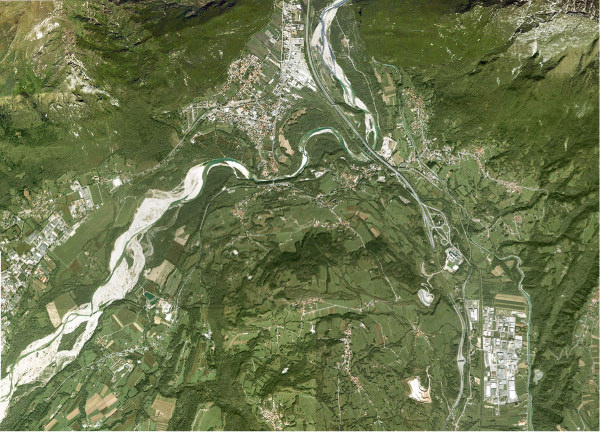
Picture of a typical area of the region.
It happens in the Alpine area of Belluno province, in a strip of land of the Italian Prealps, just beyond the plain of the Metropolitan Area of Venice.
The geographic typology is neither urban nor rural. Woods and rocks dominate the landscape. In the valleys there are built up areas, main roads, services and factories. Population density is low. Old villages are incorporated in the new expansion of buildings and infrastructures. Cultivated terracing and pastures belong to the past. Lands historically dedicated to agriculture and silviculture are mostly abandoned or converted to other uses. Farming became a hobby. A shrubbery green colour substitutes the ochre of the fields' geometric shapes of the plain. "Forest enters home" is an expression people are used to saying here.
The region developed some of the aspects of the urban sprawl, emblematic of the adjacent metropolitan area. The area suffers from loss of a centre, intended as a meeting place and space and cultural reference. The historical centres of villages and towns are often abandoned or not well connected. Exchange, cultural vitality and dialogue are slowed down by the geographical and urban configuration, especially due to long distances and lack of appropriate public spaces. The space between architectural elements is not meant to be public.
The question is how to be political (politics is intended as place of dialogue among pluralities) in a semi-rural context. What could a public cultivated space be? Can it be an alternative format to the square? Venetian squares are called campo (field), because they were originally unpaved. Can the process of food production and consumption be open and shared? What is a possible model of living landscape for areas where the opposition between urban and rural is not valid anymore?
Spazi in Frutto designed the network of Open Orchards with these questions in mind. Many efforts were dedicated to creating the orchards. After five years of field activity Spazi in Frutto is taking a break, but the debate is open to everyone who would like to contribute to it. Which actions, actors and competencies will be needed in the future in order to make the orchards hubs for cultural innovation? How can we break down the dychotomy between nature and culture?
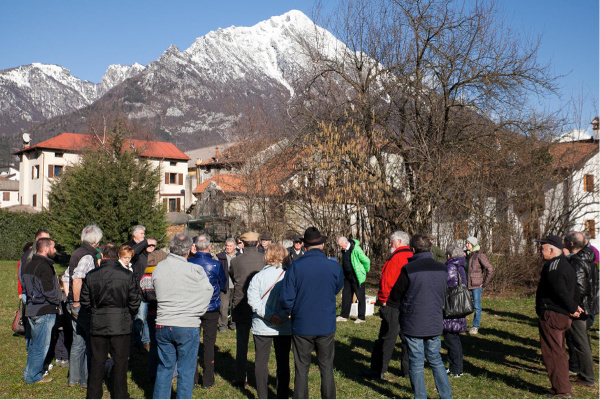
Opening of an Open Orchard.
Agricultural Resistance
There are at least two types of resistance in agriculture: the resistance of the living thing itself, that is, the resistance of the selected crop or variety to diseases, and human resistance, at a socio-political level.
The second kind of resistance refers to a community that, for instance, fights against land exploitation and impoverishment caused by intensive monoculture farming and a non-equitable distribution of wealth.
In the project's area, several movements are dedicated to agricultural biodiversity and sustainability. However, they act on a small scale, hardly coordinated. Some are radical, some moderate, some act independently, refusing any involvement from institutions and their funding, and some are simply farmers. All of them contemplate alternatives to the intensive wine and apple cultivations of the bordering regions, but there is no co-ordinated action for sustainable farming in the region
How is Spazi in Frutto situated in this framework?
It distances itself from being militant, even if it shares militancy's values. I am cofounder of Spazi in Frutto, enrolled also for my knowledge in agronomics. Spazi in Frutto aims to be a place of mediation and research that makes room for interaction and dialogue among different actors, with the certainty of doing something practical (and apparently non political): planting trees.
It is believed that ancient varieties are more resistant; however, we have not proved it. Certainly, the vigour of the plant is granted by the seedling rootstock. And the type of rootstock is also fundamental to maintain the sensory characteristics of the ancient fruit as it has been known until today. From a genetic perspective, the in-situ conservation of ancient varieties is comparable to a museum archive: it acquires a preservative value, but it is not relevant in terms of genetic improvement. The difference from a commercial cultivar on a genetic level is minimal, despite the fact that the organoleptic diversity is outstanding. With regard to the resistance to diseases and parasites, the variation is not significant: in order to introduce innovation, the research should begin from the centre of diversity of the apple, in Kazakstan.
We wanted to reproduce a tradition. Nevertheless, from a mere technical perspective, traditional fruit farming is not the most convenient choice. If the goal were simply production, it would make sense to employ a cloned rootstock, for instance.
In my opinion, the benefit of choosing these cultivars is for cultural and culinary reasons. Being cultivated and handed down for decades, they offer a rich variety of tastes, ways of consumption and different harvesting times. Some are meant to be cooked, some to be eaten when collected, some to be preserved fresh for months: each apple has its own use. Moreover, the cultivation of the different varieties guaranteed fruit supply all year round. The selection of these cultivars is the result of previous generations' needs, who could not count on industrialized and standardized food production and cool rooms.
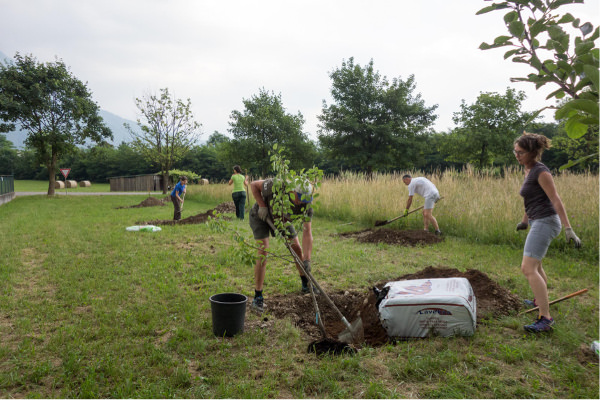
Starting an Open Orchard on public land.
Community and the Sculpture of a Fruit-Tree
Ten different Open Orchards where activated, each of them with its specific story, community and location.
One might question what makes an Open Orchard successful. Certainly, tree planting is a ritual that generates a sense of connection among participants and to place. But what happens after this?
In the best scenario, there is a community (or more than one) who uses the orchard as a structure and container for actions and thoughts. The community activates the space, uses it for different purposes, at different times, and takes care of it.
At the opposite end of this (very simplified) spectrum, there is an abandoned orchard where activities are reduced to minimal maintenance. Collective practices are absent, there is no feeling of belonging and the orchard is not perceived as part of a personal landscape.
Both scenarios are real and present in Spazi in Frutto experiments.
It is an age of decadence, at a cultural, civic and political level. The decline in citizens' participation is visible worldwide. First of all, I am a parent. I belong to the professional association of architects, landscape designers and conservators. The aim is to pass down to our children our roots and a caring attitude for the territory, wherever they will be or do in the future. Each human action affects the environment; we do not have to fear these transformations, we should rather be aware of this responsibility.
The criticism we receive as a group of volunteers is that we substitute and compensate for public services that are not provided, for deficiency of resources and capabilities, by the government. But, then, if we do not intervene, everything will stop working.
"Only 'we' counts in social causes, not 'I.'" I am quoting Luigi Ciotti.2
The best scenario takes place in a village called Pieve di Cadore. Thanks to Spazi in Frutto's support, a local association of parents decided to transform the school's little vegetable garden into a great public park.
The school is attended by a total of four-hundred students and around two-hundred parents joined the project. Other associations and citizens collaborate too. All the work has been done by volunteers, so far. Some adults founded an association dedicated to active participation and action in public life. A group of students and parents meet every Tuesday, from 3:00 pm to 5:00 pm, to enjoy taking care of the Open Orchard.
The story is different for the first Open Orchard. It is placed in a piece of public land set among blocks of flats. In terms of collective engagement and despite the participatory workshops carried out in this space, we consider it a failure. Conflicts have occurred and there is a general feeling of distrust and irresponsibility among the local inhabitants. Once a lady from the neighborhood confessed to have had stealthily watered the narcissuses of the orchards and another one asked if children were allowed to eat the fruits.
From the twelve original plants placed in three rows, nine survived generating a curious spiral arrangement. Nevertheless, the trees are present.
Tree planting is a gesture and the orchard is a sculptural presence originating from that event, a sort of public monument which could last hundreds of years, witnessing dialogues, games, conflicts and stories.
Community is at the core of the success or failure of a project. Assuming that the archive is the pre-text for action, community is the material and the environment at the same time. The gesture is the action of planting fruit trees on a common land, as part of a community commons. Where we lack in building community, the intervention is reduced to a sculptural act.
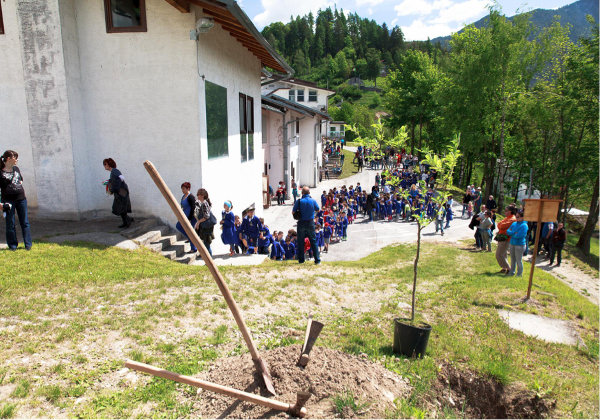
The opening of the Open Orchard in Pieve di Cadore.
Matters of Time
Resilient means lasting.
How do we relate to something old and respected which is believed to have been always there, in other words, a tradition?
Matters of Time dresses the issue of how to bring to life what is preserved and archived.
Our progenitors used vigorous and resistant seeding rootstock that needed few interventions and treatments. The trees would have become centuries-old, high and large in size. They would have provided food for several generations. Plentiful fructification would have started between ten and twenty years after being planted.
Spazi in Frutto is a gamble: it demands a long-term vision, whereas we live in a sort of existential precariousness, not knowing what job to do, what studies to complete, which country to live in. Our lives lack a centre.
From my window, I can see one of those ancient pear-trees.
*Wild and on its own, proud, stretched to the sky. The dinosauric trunk witnessed the age of subsistence farming. It stands up, with its beauty, loaded with yellow and oblong spots. On its foot, the soil is squashy and fruity. *
Seraphic, it bears fruits, attracting the admiration of some neighbours (who dream of climbing on it and pick all the pears!) and the embarrassment of others, who see it as an old, out-of-place and out-of-proportion tree, that must be chopped down.
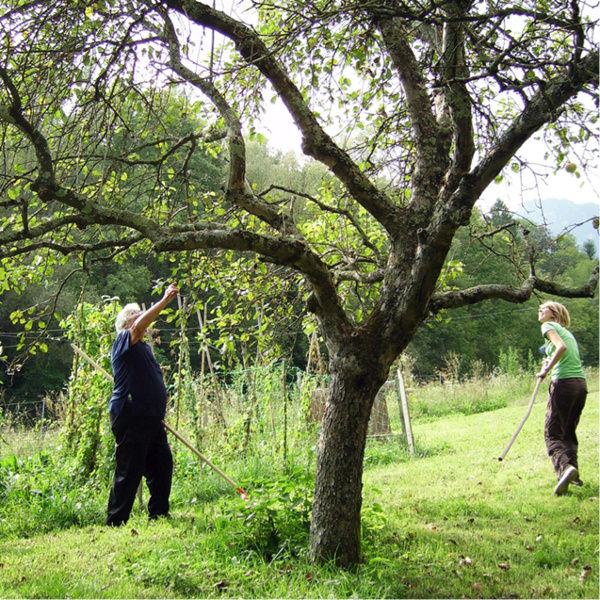
Census of ancient fruit trees.
2017 To-do List
- Keep the association operative, as technical support for the next projects
- Do what is most exciting, respect our energies
- Conclude the paperwork of the year
- Write about Spazi in Frutto. Keep track
- Visit the ten gardens and contact the community for feedback
- Website
- Pruning the trees once a year
Footnotes
- Nadia Breda et al., Biodiversità Coltivata nel Parco Nazionale Dolomiti Bellunesi: Indagini Agronomiche ed Etnobotaniche sulle Varietà dell'Agricoltura Tradizionale (Belluno: Parco Nazionale Dolomiti Bellunesi, 2006) ↩
- Luigi Ciotti is a priest deeply involved in the fight against illegality and organised crime such as the Mafia. He was born in the same town where the school orchard takes place and, therefore, he represents a model for the local community. ↩

